G Minor Chord On Guitar: Diagrams and Theory
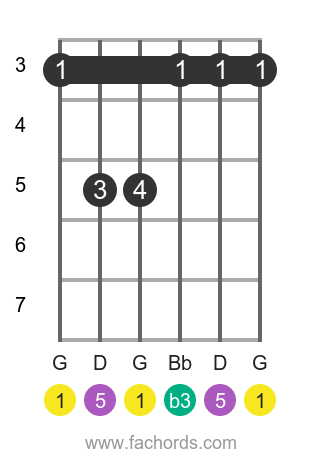
Welcome to our tutorial on the G minor (G m) chord. This chord, a member of the Minor Chords family, is constructed with the notes G, Bb, and D. The intervals that build this chord are the 1 (Root), b3 (Minor Third), and 5 (Perfect Fifth).
Understanding the notation of these intervals is crucial to mastering the G m chord. It's a part of the larger world of guitar chords, and you can learn more about this in our full tutorial on guitar chords.
As you delve into the G m chord, you'll discover that it's about more than just the notes and intervals. It's about how these elements come together to create a distinct sound. To learn more about how chords are built by stacking intervals, check out our guitar music theory tutorial.
The G m chord is a stepping stone to more advanced chords. Once you've mastered it, you might want to explore more advanced chords. And, if you'd like to understand how to invert intervals in a chord to get new shapes, our chord inversion tutorial is a great next step.
Finally, if you're unsure about any chord shapes shown on the fretboard, remember to use our interactive tool to analyze chord shapes. It's a handy tool for any guitarist, beginner or advanced. Happy playing!
Notes of the G m chord:
Chord Formula:
G Minor Chord | Common Shapes And Keys
In the following, we're going to see some G minor chord fingering options.
Before beginning, one warning:
Often, the stripped-down version of a chord does not sound as good as the original.
It is theoretically correct, and easier to play, but lacks sound richness.
Feel free to use it while learning, but your final target should be the standard shape, unless your musical taste suggests otherwise!
The G minor scale
We're not going to give a full lesson on harmony here, you only should know that a minor chord is constructed starting from its relative minor scale, taking the first (root), the 3rd and the 5th notes.
If you want to learn more about this, have a look at our chords formula tutorial.
Here's the G minor scales and its degrees:
G (1) A (2) Bb (3) C (4) D (5) Eb (6) F (7) G (8)If we take the root, the 3rd and the 5th degrees of this scales, we have the tones that compose a Gm chord
G (1) Bb (3) D (5)How we can apply what we learned so far to the guitar?
Well, if we have a look at the fretboard and where the three notes above are placed, we can start reasoning about our fingerings.
The G minor tones on the guitar fretboard
In the fretboard diagram below are shown the notes composing the G minor chord. Don't you know the notes of the fretboard?
Then you might find useful our guitar fretboard notes tutorial.

Did you spot already a easy Gm fingering? No?
Don't worry, now we're going to see how to pick some of the notes shown above for creating our cool chord shapes.
On the guitar, once we know what notes compose a chord, we can take any of these notes on any string for creating our chord shapes.
There are some rules, that are not strict but just guidelines:
- We can include a note in the chord one on more time, on any string and fret
- The root of the chord, G should be always included. We can
include it twice (on different strings) to give
it more power.
(Note: If you play with a band, this rule often does not apply, because for example is the bass player that plays the root).
- The 3rd of the chord, Bb should be always present (because it's the tone that makes that gives a major or minor feel to the chord)
- The fifth, D is the less important degree, but in this case, we'd like to include it as well.
- Some fingerings sound very good, others not so good, it's a matter of personal taste, experience and feeling.
Super easy G minor chord with just 2 fingers
The easiest fingering for the G minor chord is shown in the following picture:
- Place your ring finger on the 3rd fret of the E low string
- Place your index finger on the 1st fret of the A string
- Play the D string open (without pressing any fret)
- Play the G string open (without pressing any fret)
- Do not play the B open string
- Do not play the E high string
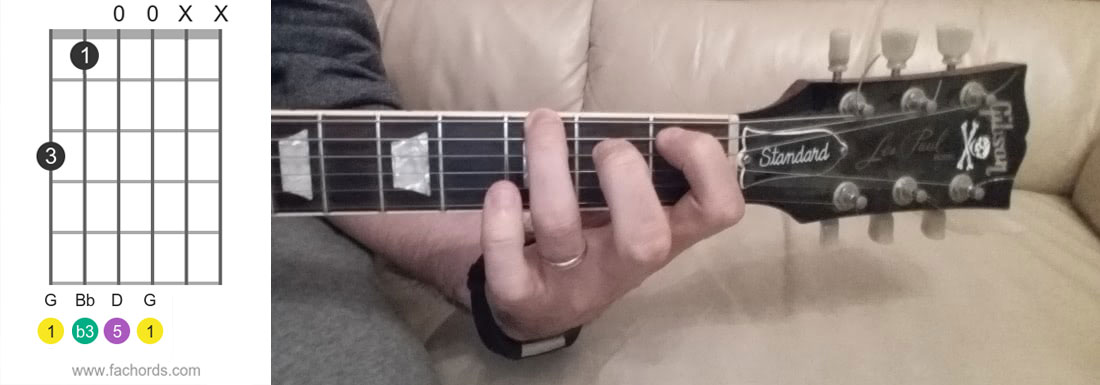
Classic G minor chord with root on the 6th string
The following fingering is the most used for the Gm chord.
It's a bit challenging because it requires a full barrè all over the six strings, but it's a great shape to practice for gaining strength.
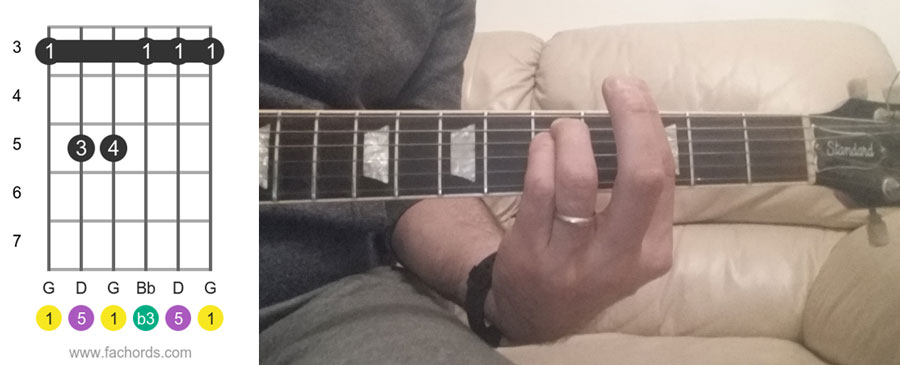
G minor chord with root on the 5th string
This fingering has a five strings barrè, and its taken in the higher fretboard position.
Be careful to mute the E lowest string, as E does not belong to the Gm chord.
This position is used a lot in funk and reggae music.
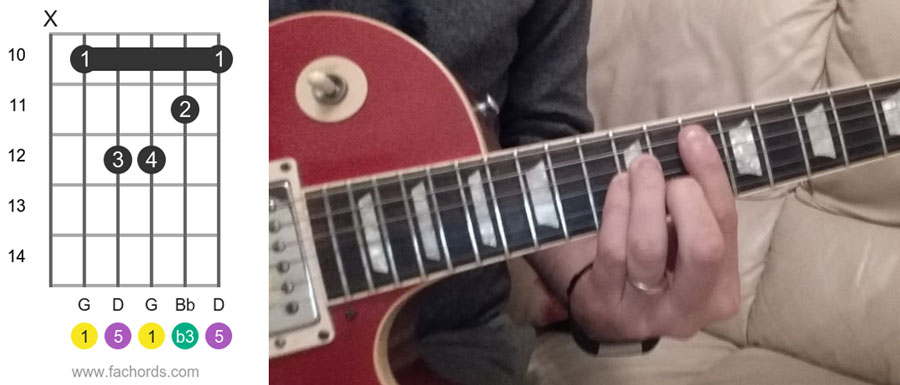
Keys with the G minor chord
Here below you find the most common keys (major and minor) that have a G minor chord on one of their degrees.
Major keys containing a Gm chord
F major key
| Key | I | ii | iii | IV | V | vi | vii |
|---|---|---|---|---|---|---|---|
| F | F | Gm | Am | Bb | C | Dm | Em/b5 |
Eb major key
| Key | I | ii | iii | IV | V | vi | vii |
|---|---|---|---|---|---|---|---|
| Eb | Eb | Fm | Gm | Ab | Bb | Cm | Dm/b5 |
Bb major key
| Key | I | ii | iii | IV | V | vi | vii |
|---|---|---|---|---|---|---|---|
| Bb | Bb | Cm | Dm | Eb | F | Gm | Am/b5 |
Minor keys containing a Gm chord
G minor key
| Key | i | ii | III | iv | v | VI | VII |
|---|---|---|---|---|---|---|---|
| G | Gm | Am/b5 | Bb | Cm | Dm | Eb | F |
D minor key
| Key | i | ii | III | iv | v | VI | VII |
|---|---|---|---|---|---|---|---|
| D | Dm | Em/b5 | F | Gm | Am | Bb | C |
C minor key
| Key | i | ii | III | iv | v | VI | VII |
|---|---|---|---|---|---|---|---|
| C | Cm | Dm/b5 | Eb | Fm | Gm | Ab | Bb |
G Minor Guitar Chord Shapes
Chord boxes are sorted from the easiest to the hardest. Learn how to read chord diagrams.
If you have difficulties with bar chord shapes, check the Bar Chords Tips tutorial.
You can also use this accessible chords page with written diagrams instruction.
Position 1
Movable
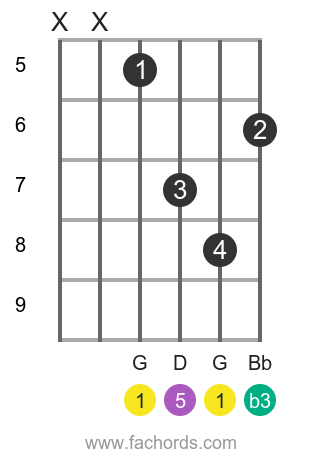
Position 2
Barre
Movable
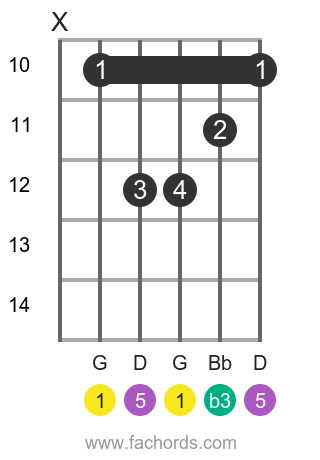
Position 3
Barre
Movable

 You can find more shapes in our all guitar chords online library. If you
prefer a printable pdf, download
the Free Guitar Chords Chart Pdf
You can find more shapes in our all guitar chords online library. If you
prefer a printable pdf, download
the Free Guitar Chords Chart Pdf